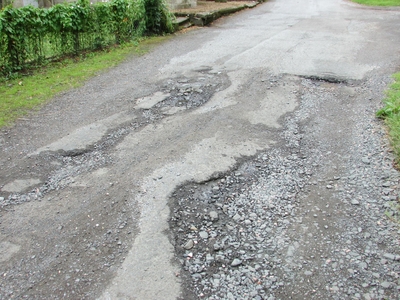Why Potholes Are Bad For Your Car
Potholes can be a real nuisance for a driver, especially large ones. Following the winter months, many of us have found more potholes on our roads. Potholes can cause damage to your vehicle, depending on the speed at which you drive over them and the size of them. In this article, we’ll discuss the damage they can do, and what you can do to avoid them.

How are potholes formed?
Potholes are caused by water under the road freezing during cold temperatures, and therefore breaking the road surface. When cars then drive over the damaged road, the surface weakens, leading to damage and eventually forming a pothole.
You can report a pothole on the government website.
Punctures
Pothole punctures are one of the most common types of damage caused by a pothole. If a vehicle drives over a pothole too quickly, the impact can cause the tyre to crack. This leads to a puncture, and in turn, a new tyre will be needed for the car.
If a puncture is left untreated, the tyre will deflate which could cause a loss of control. If you have a puncture and want to order new tyres for your car, click the link below.
Find Tyres
Tyre bulges
Hitting a pothole at speed can also cause a tyre bulge. A tyre bulge is where the tyre sidewall has been weakened or damaged. This can lead to the tyre popping or deflating, which could make the car un-driveable. To book a FREE tyre check for your vehicle, click the link below.
Free Tyre Check
Suspension damage
Potholes can cause your suspension to become misaligned. This means that your suspension is at the wrong angle, so your tyres will also be at the wrong angle, leading to a loss of control over your vehicle. You may notice this if you have uneven tyre wear or your car pulls to one side when driving.
If your car is bouncing whilst driving, then the suspension or shock absorbers may have broken. This can be very dangerous as it could cause you to lose control of the car whilst driving. To have your steering and suspension repaired, click the link below.
Suspension Repair
Wheel damage
A pothole may bend or crack your wheel. This can lead to the wheel bursting whilst driving, which could result in a loss of control. To check if your wheels are in working condition, you’ll need to clean them and then carefully inspect for any cracks or bends.
If you think your wheel might have been cracked by a pothole, you can book your car in for a FREE safety check using the link below. We can also check your brakes, battery and oil during this check.
Free Vehicle Check
How can you prevent potholes from damaging your car?
The main way to prevent any damage from being done by potholes is to reduce your speed when driving over them. At a slower speed, you are less likely to cause any damage to your vehicle, and you’ll have more control over the car. A slower driving speed will also help prevent any pothole punctures.
If a pothole is very deep and wide, you may want to avoid it by driving around the pothole. However, only do this if it is safe to do so.
Did you enjoy this blog post? |2 people found this review helpful



